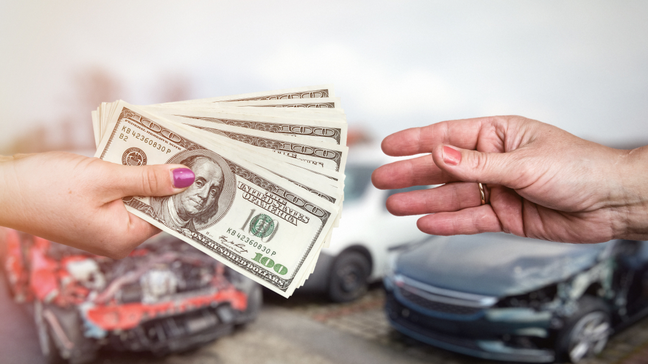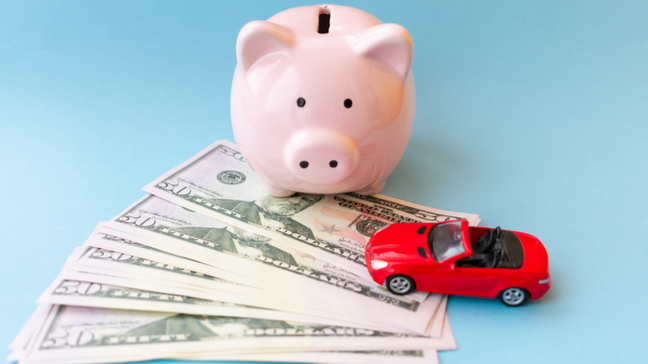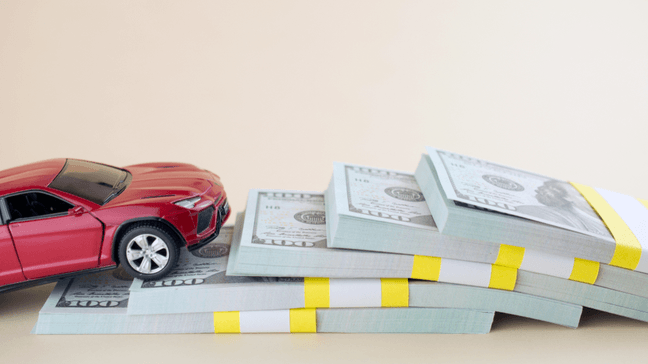To start, it’s my crazy-strong recommendation that you spend 30 minutes shopping for a better car insurance rate every six months.
When you do, you’ll inevitably be asked about gap insurance.
So what exactly is gap insurance, and do you need it?
Auto insurance providers tend to be a little vague about gap insurance and what it does, and it’s not entirely their fault. Gap insurance is somewhat complex, as are the calculations to determine whether you need it or not.
So in this piece, that’s exactly what I’m going to tackle:
- What exactly is gap insurance?
- How does it work?
- When do you need it, and when is it safe to skip it?
Let’s investigate together.
What is gap insurance?

In brief, gap insurance covers the “gap” between:
- The actual cash value (ACV) of your car.
- The amount you still owe on your auto loan or lease.
Funny enough, the name “gap” actually comes from the acronym Guaranteed Auto Protection. It’s rather convenient that it happens to cover a literal “gap” between two numbers.
Anyways, gap insurance applies most often when you buy or lease an expensive new car that depreciates quickly. If the depreciated value of your car falls below your potential insurance payout, a “gap” of potentially thousands of dollars can form.
When you owe more than your car is worth, you’re underwater. This applies to homes and other assets that can be financed.
Being underwater on a car loan is no bueno. Crashing your car is bad enough; still owing thousands of dollars on it is even worse. That’s why many drivers opt for gap insurance to ensure that never happens.
Gap insurance won’t cover your deductible, but it covers most of your financial burden after a total loss, so it can be a big stress reliever.
So how much does it cost, is it worth it, and when do you need it?
How much does gap insurance cost?
Gap insurance is typically an add-on to collision and/or comprehensive coverage since it covers the delta between what those coverages pay out and your outstanding loan amount.
The price for adding gap insurance can vary by provider, but it’s generally between $20 and $100 annually, averaging around $50 or $60.
A word of caution: don’t buy gap insurance directly from the dealership or your lender. They’ll want to charge you $500 or more, their logic being you should pre-purchase gap coverage for the entire life of the loan.
But this is (yet another) manipulative dealership sales tactic. You don’t need gap insurance for the entire life of an auto loan because 99% of the time your gap will disappear well before the end of the loan. You’re much better off paying $50 or so annually through your insurance provider because:
- It’s cheaper.
- You can cancel it as soon as your gap disappears.
So how does a gap form, and when does it disappear?
How does gap insurance work?
To illustrate how gap insurance works, I’m going to give two examples:
- A “no gap” example where gap insurance isn’t necessary.
- A “big gap” example where it definitely is.
To preface, I’ll be using examples where we’re buying new cars since it’s simpler. But for leases, gap insurance works much the same way; if you crash your lease, your dealer will charge you as if you just bought the car, minus your down payment and past monthly payments.
Example #1: no gap = no gap insurance needed
Let’s say you decide to purchase a 2021 Mazda Miata (good choice).
The car costs $30,000 on the nose. You put 20% down, bringing the principle of the loan down to $25,000. Since you have such a high credit score you qualify for 0% APR, so you’ll have 48 payments of $521.
After three months of blissful top-down driving, you misjudge a tight corner and put your poor Miata into a wall. The insurance company calls it a total loss. Goodnight, sweet prince.
Anyway, because you had good collision coverage, your provider cuts you a check for the actual cash value (ACV) of the Miata. Your car’s ACV is basically what it would’ve sold for on a used car lot before the crash – essentially the MSRP minus depreciation.
Most brand new cars lose 10% of their value within a month of driving off the dealer lot and 20% after one year. In your case, after three months, the ACV of your 2021 Miata was 15% lower than the MSRP.
So here’s what your insurance company will pay out:
- New 2021 Miata price: $30,000.
- Up to 15% loss in value due to depreciation: $4,500.
- Actual cash value (ACV): $25,500.
- Minus collision deductible: $500.
- Total insurance payout: $25,000.
Now that you have your $25,000 check, let’s look at your outstanding loan amount.
- New 2021 Miata price: $30,000.
- Down payment: $5,000.
- Loan amount: $25,000.
- Minus three payments of $521: $1,563.
- Amount still owed: $23,437.
In this case, the payout from your insurance provider is higher than the outstanding loan amount. You pay your lender $23,437 and you’re still left with $1,563 to apply to a down payment on a new car.
- Total insurance payout: $25,000.
- Amount still owed on auto loan: $23,437.
- Gap: – $1,563.
No gap, no gap insurance needed.
There are a few crucial reasons why a gap didn’t form in this scenario:
- You made a solid 20% down payment.
- Your car was cheap ($30,000, compared to the average new car price of $41,000).
- Your loan term was short (48 months, which is the maximum I recommend personally).
- Your car depreciated at an average or below average rate.
All of these factors contributed to gap prevention – especially your 20% down payment and the car’s slow depreciation.
Now, let’s look at an example where a big gap forms…
Example #2: big gap = gap insurance needed
Sure, Miatas are great, but you’re looking for something a bit more… executive.
So you head to the car dealerships in the Whole Foods-y part of town and treat yourself to a slick new BMW 4-series. You’re not bothered by the bucktooth grill since, well, you’ll be inside the car – everyone else has to look at it.
The Bimmer costs $66,000 and you choose to put just 10% down, bringing the total loan amount to $60,000. Your credit score is high enough that you qualify for 0% APR financing for 60 months, so your monthly payment will be exactly $1,000.
(It’s worth mentioning at this point that I’m in no way endorsing this plan…)
After three months, you get a little overzealous with your 382 horsepower and slide your poor Bimmer into a retaining wall. With the gopher-mobile out of commission, let’s look at what insurance will payout.
Now, anyone shopping for a luxury sports car should know that these cars depreciate like milk. German luxury and performance cars especially tend to lose up to 25% of their value within months. So when your insurance check comes, you’re in for an unpleasant surprise.
Let’s take a look at the numbers:
- New 2021 BMW 4-Series price: $66,000.
- Up to 25% loss in value due to depreciation: $16,500.
- Actual cash value (ACV): $49,500.
- Minus collision deductible: $500.
- Total insurance payout: $49,000.
With great trepidation, let’s now look at your outstanding loan amount:
- New 2021 BMW M440i price: $66,000.
- Down payment: $6,000.
- Loan amount: $60,000.
- Minus three payments of $1,000: $3,000.
- Amount still owed: $57,000.
Due to a low down payment, a longer loan term, and other factors, the gap here is pretty eye-watering.
- Total insurance payout: $49,000.
- Amount still owed: $57,000.
- Gap: $8,000.
So not only are you now without a car, you still owe your lender the price of a used Corolla for a car you’ll never ever see again. This is an aggressively un-fun place to be in, so gap insurance is virtually a requirement in this scenario.
Do I need gap insurance?

Gap insurance is a good idea if you’re at risk of a gap forming between your car’s actual cash value and your remaining loan amount. Here are scenarios that can lead to that happening.
You may need gap insurance if…
Oftentimes, your lease or loan agreement may require gap insurance. If so, just remember to buy it on your own, if possible.
If gap insurance isn’t required by the terms of your loan or lease, you may still want it if you can potentially go underwater.
That can happen if your loan or lease payment plan involves one or more of the following “gap makers.” Just one of these factors alone could contribute to a $1,000+ gap forming between your car’s actual cash value and your remaining loan amount.
Here’s a list of those gap makers:
- Buying/leasing a new car instead of a used one.
- Buying/leasing an expensive car ($50k or more).
- Buying/leasing a luxury/sports car that depreciates quickly.
- Making less than a 20% down payment.
- Extending your loan term past 48 months.
- A high interest rate.
You can safely skip gap insurance if…
You’re fine without gap insurance if your car payment plan doesn’t run the risk of a gap forming in the first place.
For example, if your plan involves the following:
- Buying/leasing a cheap car under $30k.
- Buying a used car that’s already past its 15%-30% year one depreciation.
- Buying/leasing a new car that depreciates slowly (like a 911 or a Japanese car).
- Making a large down payment (20% or higher).
- Having a short loan term (48 months, max).
- Securing a low interest rate.
You’re probably safe from a gap forming. Generally speaking, buying a cheap, used car with a short loan term is the best defense against going underwater on a loan.
When will my “gap” close?
In order for a gap to disappear, the remainder of your loan needs to catch up to your car’s actual cash value. Let’s look at what happens one full year after the date of purchase:
First, let’s calculate the BMW’s ACV after 12 months:
- New 2021 BMW 4-Series price: $66,000.
- Up to 30% loss in value due to depreciation: $19,800.
- Actual cash value (ACV): $46,200.
- Minus collision deductible: $500.
- Total insurance payout after 12 months: $39,700.
Now, let’s look at your outstanding loan amount after 12 months:
- New 2021 BMW M440i price: $66,000.
- Down payment: $6,000.
- Loan amount: $60,000.
- Minus 12 payments of $1,000: $48,000.
- Amount still owed: $48,000.
- Minus insurance payout: $39,700.
- Gap after 12 months: $8,300.
Yikes!
So despite 12 months of $1,000 payments, the gap on the BMW has gotten wider. This is because new cars, and especially BMWs, depreciate so quickly in their first year.
If your car is losing value faster than you’re paying it off, you need gap insurance.
Depreciation can level off after year one, so let’s look at what happens after 18 months.
Here’s the ACV at 18 months:
- New 2021 BMW 4-Series price: $66,000.
- Up to 40% loss in value due to depreciation: $26,400.
- Actual cash value (ACV): $39,600.
- Minus collision deductible: $500.
- Total insurance payout: $39,100.
Now, your outstanding loan balance after 18 months:
- New 2021 BMW M440i price: $66,000.
- Down payment: $6,000.
- Loan amount: $60,000.
- Minus 18 payments of $1,000: $18,000.
- Amount still owed: $42,000.
- Minus insurance payout: $39,100.
- Gap after 18 months: $2,900.
So, your 4-Series gap will close around 21 months after the date of purchase. So you’re definitely safe canceling gap insurance after year two, costing you only ~$150 for both years. That’s a lot cheaper than the $700 the dealer wanted!
The need for gap insurance is a potential red flag

In my opinion, the need for gap insurance is a red flag. Here’s why.
Gap insurance serves to protect you if you go underwater on your loan or lease. But if your loan terms leave the potential to go underwater, that’s a sign that you may need to consider the terms of your payment structure or look at a more affordable car.
These are the three main circumstances in which gap insurance becomes necessary:
- Buying/leasing a brand new car.
- Making a low down payment.
- Extending your loan term past 48 months.
Frankly speaking, all three are situations that I advise my friends and clients to avoid:
- If you can skip the lease and finance a three-year-old car instead, you’ll save 50% off MSRP and you’ll actually own the car. It’s a depreciating asset, sure, but still, one that you can sell in a pinch.
- A high down payment reduces your total loan amount, and thus your total interest paid.
- Short loan terms also reduce your total interest paid and the length of time you’re vulnerable to missed payments and crippled credit.
In short, gap insurance helps to protect you from going underwater in the event of a total loss. But in my subjective opinion, it’s best to avoid loan or lease terms that expose you to going underwater in the first place.
But what about leases?
A lease is a much more affordable way to drive off in a brand new car, and it also won’t expose you to quite as much risk as a loan. Plus, if you make a sizeable enough down payment, you may eliminate the possibility of a gap forming in the first place.
Even still, I still don’t recommend leases.
If you’re dying to drive a 2021 model and you don’t mind paying a little extra for the new car smell, hey, power to you. But if you can wait just one year, or just buy last year’s model, you’ll not only get a discount of up to 30% – you’ll avoid the “gap” entirely.
Summary
Gap insurance, or “guaranteed auto protection,” covers the “gap” that can form between:
- The amount your collision or comprehensive insurance will pay out in the event of a total loss.
- The amount remaining on your loan or lease payout.
Gaps typically form when a car depreciates faster than you can pay it off. Making a low down payment and extending your loan terms past four years can exacerbate the gap, increasing your financial liability after a total loss.
While gap insurance is cheap (~$60/year) and most buyers will only need it for two years, determining that you need gap insurance in the first place may be a red flag in and of itself. The potential to go underwater on your loan or lease may indicate that your terms are risky, unfavorable, or both.
You’re better off financing a gently pre-owned car with a large down payment, low interest, and a short loan term of 36 to 48 months. Don’t pour your money into a depreciating asset – invest the rest!